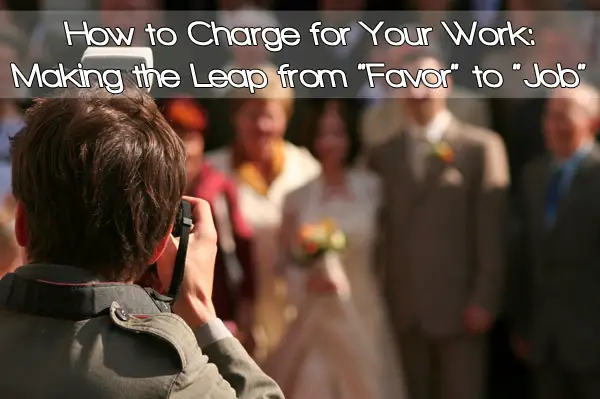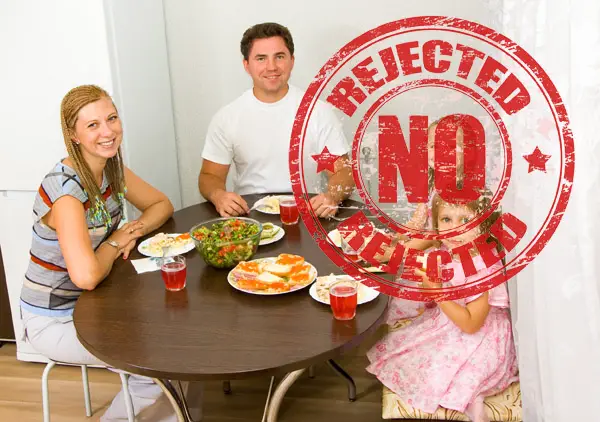So you’ve got a passion for photography, a slew of great photos that show you’ve really got talent and the desire to transition your photography skills from something that has been strictly a hobby into something that will allow you to earn money. What happens next? If you’re like most folks, you may start by offering to take photos of your friends and family to build up your portfolio and your confidence—which is a smart move.

But you can’t stay in “building your portfolio” mode forever; if you do want to do this as a professional and earn money at it, you’re going to have to start charging at some point. There’s no doubt it can feel scary and intimidating the first time that you tell friends or family that you will be charging them for your photography work. But by following a few tips, transitioning from hobbyist to professional-in-progress should be a bit easier:
Shift the conversation from “favor” to “job”
Initially, many of your potential clients will be family and friends—and while you understandably may decide to continue doing some photography for free, you need to be ready with a quick response if you’re approached do a photography “favor” that you really look at as a “job.” What’s the best way to do that? By practicing what you’d say so you don’t feel like you’re stumbling over your words. Consider this scenario:
“Jen, you’re such a great photographer and we love the photos you did for your sis and her family,” says your sister’s best friend Liz. “Would you mind coming down to the beach and taking shots of me and Jim and the kids? We’ll even invite you to stay for dinner!”
In this scenario, you’re being asked to take the photos as a favor—and the “payment” being offered is dinner. Unless you’re great friends with Liz and Jim and want to do this for them as a gift, you need to be ready to come back to requests like this with a friendly response that reframes the request in a way that better suits your business interests.
“I’m so glad you liked the photos!I took those photos for sis to help bolster my portfolio as I’m starting my photography business…and it seems to be working. I’d love to do your family photos this Saturday but I don’t think dinner is an option; let me check my calendar and I’ll email you with times that I’m available and my fee schedule and you can let me know what works best for you.”
By giving Liz the response above, you’ve done a few things: You’ve thanked her for her compliment of your work and let her know that you’re flattered by her request, and you’ve also introduced the concept of your photography business — and by letting her know that dinner isn’t likely an option, you’re sending the subtle (but not unfriendly) signal once again that this is business. Finally you’re letting her know what to expect from you so that she can take the next steps.

If this feels weird for you, think about it this way: Your friend’s sister, a hairdresser, doesn’t and can’t afford to give everyone she knows free haircuts or highlights. Your brother-in-law, the accountant, isn’t in the position to do everyone’s taxes as a favor. Just because a friend or family member has a particular skill doesn’t mean they are obligated to use that skill for free! As a person who is starting your professional photography career (even if it’s secondary to your day job, or to raising your kids) you owe it to yourself to set clear boundaries.
Look professional!
If you want to make the transition to getting paid for your work, you have to look the part. That means that in addition to being ready with answers that shift the conversation from
“favor” to “job”, you also need to have business-focused information and materials at your fingertips.

Consider this scenario:You’re at a neighborhood barbeque and as your neighbor Bill is walking out the door, he asks you if you could take photos of his wife’s Cocker Spaniels as a holiday gift for her. Which option makes more sense?
Option 1: You say, “Sure, let me get you my email address and we’ll work out the details” and you rummage for a semi-blank piece of paper in your purse on which you jot down your email address,[email protected]
Option 2: You say, “Sure, let me get you my email address and we’ll work out the details” and you grab a business card from your purse pocket, which has your [email protected] email address printed on it.
If you want to charge for your work, which option sends a clearer message that this isn’t a hobby, but a business (or at least a business in progress?) You’re absolutely right, it’s option 2. Spending a few dollars on business cards is a huge investment in setting the right tone with people, and in making it easier for you to send the message, “Hey, this isn’t a freebie” without feeling like you need to be obnoxious about it.
Looking professional extends beyond business cards, however. As you’re continuing to expand your photography business and build upon your experience as a professional photographer, consider setting up business-focused social media accounts as well. That way, if Bill says “I don’t want to email because it’ll ruin the surprise for my wife—I’ll just look you up on Facebook” you can quickly let him know to search for “Jen Smith Photography” versus sending him to your personal Facebook profile.
Starting with low pricing makes sense
When you’re just starting to make the transition from hobbyist to pro, you should keep your pricing low—and you should let prospective clients know that your pricing is so low because you’re building up your professional photography portfolio and are discounting fees for your first customers as a result. Initially pricing low will allow you to literally undersell and over deliver, and will give you time to gain confidence in yourself and your abilities—as well as giving you the chance to get used to the business side of photography.

How do you know where to set your initial pricing? Research. Pricing is much different for senior portraits than for family portraits or even pet portraits, so whatever you’re going to focus on, get online and see what the typical price range is for those types of photos in your area. Then come in below that pricing or start on the low end of it.
Increase fees as you increase customers
As you gain experience and feel more confident, you can begin to charge fees that are less “bargain basement” and are more in line with “the going rate.” One way to do this is by increasing your fees by 10% each time you take on a new job, which will allow you to gradually increase your income—so the 1-hour photo shoot that you charged $100 for today would cost your next client $110.
However, if you find that you’ve got more interest and more photography work coming in than you can handle, you may want to consider a larger increase per client, along the lines of 20-25%. Continue bumping up your fees at a rate you feel comfortable with until they’re in line with others in your area.
The More You Do It, the Easier It Gets

Charging for your photography work is like riding a bike—once you learn how to do it, it’ll seem easy! By being prepared to reframe requests for “favors” into “jobs”, looking professional, setting you initial pricing low and then having strategies for increasing it, you’ll be well on your way to building the photography business you’ve always dreamed of!
This article was created by Director of Marketing at Nations Photo Lab, Chris Therkildsen. Nations Photo Lab is a premier online photo lab that delivers high quality professional products to photographers and weekend hobbyists.









About the pricing, I must disagree with you, if you start low, that will be your set price, there is no way you can charge more, especially when it comes to referrals since they have already talk with each other. you will often hear ” oh why so and so paid this much, and I have to pay more”.
you will have problem to even justify any increase due to inflation, price increase or any other factor beyond your control, especially during this hard times.
After working for more than 30 years I have learnt there is better approach.
you see if your prices are sky-high and give the client discount, (with reasoning the fact they are your first clients to being some kind of holiday, or any other excuse you may need to allow you to extend them the discount, this works much better plus they feel they are getting special treatment).
I know this from the fact, if your prices are high, you can always reduce them, but if they are low, you will NOT able to increase them, or do it without losing quiet few of your clients.
simply put, you will get whatever price you set, and would be very hard to move away from that set price.
Hello, Sid! Thanks for the response a lot! I am not the author of the article to argue, nor am I working in photography field where I could the pricing myself, but your statements sound reasonable, thanks for sharing!
you are welcome, anytime.
I totally agree with you, Sid! Starting low is a good recipe for troubles. I prefer the decreasing discounts strategy, so the first few customers will get a discount as an special “favor” and not as the actual price. When a referred friend ask for a quote, they will only get the discount if they ask for it and, even then, you still have room to give them a lower discount rate.